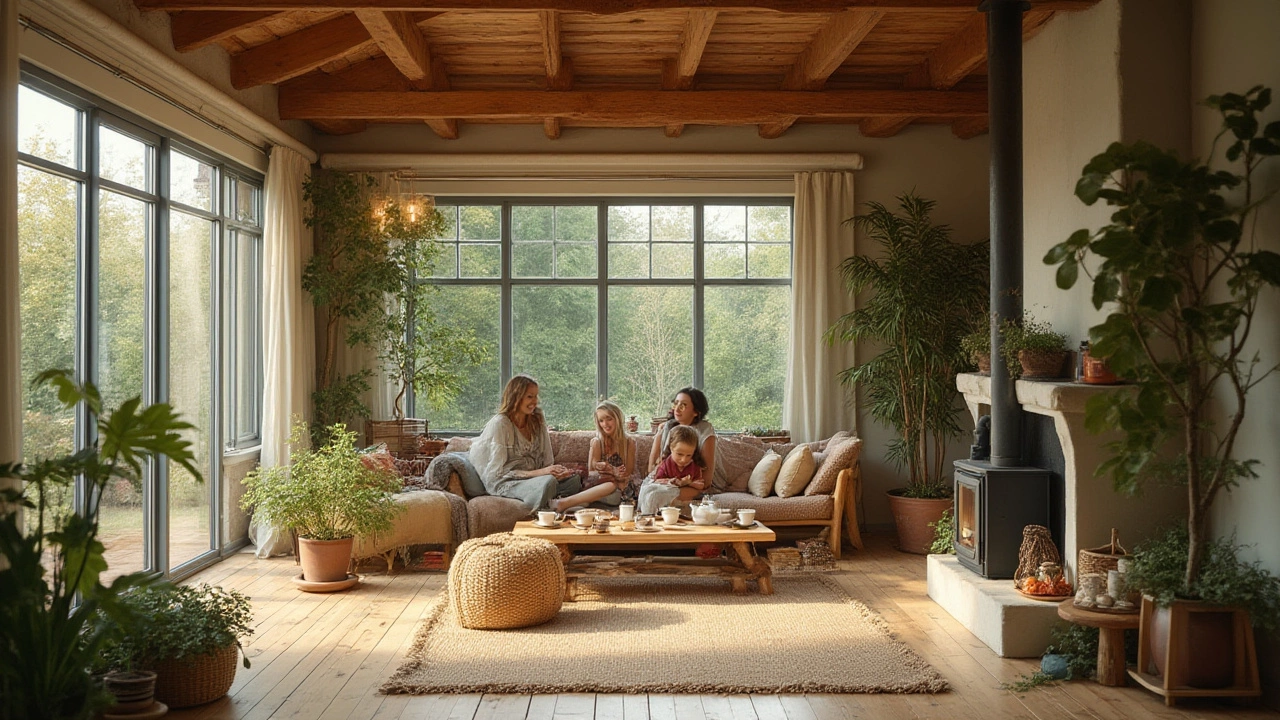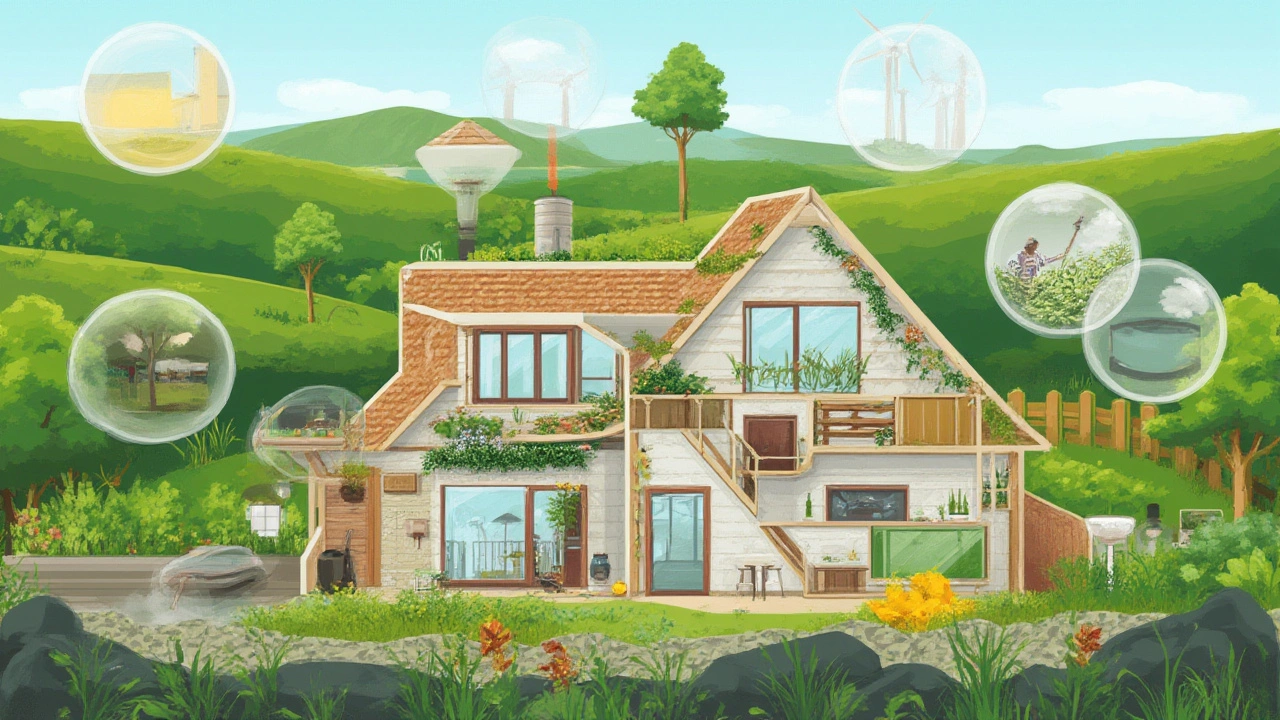Ever wondered where comfort and nature actually respect each other? That’s what eco cottages are all about. Forget the idea of just another cabin in the woods. An eco cottage makes your getaways—or even your full-time living—gentle on the planet, without forcing you to give up modern comforts. They’re popping up more than ever, from wind-swept coastlines in South Africa to forest spots in Scandinavia. It’s not just a passing trend, either. Green building has gotten so practical, stylish, and surprisingly affordable that even city folks are considering downsizing to a greener footprint. Here’s the real story—warts, wins, and clever tips.
What Makes a Cottage “Eco”? Sustainable Materials and Smart Design
There’s no single blueprint, but a true eco cottage always starts with its bones: what it’s made from and how it breathes. Builders ditch resource-intensive stuff and often go for eco friendly cottages built with recycled, reclaimed, or fast-renewing materials. Think bamboo flooring, reclaimed brick, compressed earth blocks, and even old shipping containers. A lot of architects will try to use what’s already on site—like timber from the land, rocks for walls, or even mud mixed to form adobe. In South Africa, it’s no surprise people love stone-and-earth mixes, since they naturally keep homes cool in summer and warm in winter.
The green cred doesn’t stop at walls and floors. Insulation plays a massive role. Sheep’s wool, cellulose from recycled newspapers, and even cork are favorites for trapping heat (or keeping it out). Windows get positioned to suck in winter sunlight and block harsh summer rays. Roofs are sloped for rainwater harvesting. In fact, the Green Building Council of South Africa notes that smart orientation and insulation can slash heating costs by up to 50%—a big deal when you’re in a place where energy isn’t cheap or always stable. Take a look at this brief table on material comparison:
| Material | Eco Rating | Typical Use | Comments |
|---|---|---|---|
| Bamboo | High | Floors, Joinery | Rapidly renewable |
| Recycled Timber | High | Frames, Furniture | Reduces logging |
| Earth Blocks | High | Walls | Excellent insulation |
| Concrete | Low | Foundations | High carbon footprint |
| Sheep’s Wool | High | Insulation | Natural & biodegradable |
The smaller size of most eco cottages cuts down on the resources needed to build and keep them running. Think compact layouts that skip corridors, or furniture that doubles as storage. Less is more. But don’t picture one-room huts—some of the best are clever with space and pack in cozy nooks, lofts, and decks with killer views.
Builders follow local traditions and modern green tricks. For example, in Cape Town, the local fynbos garden often wraps the structure, which reduces water use and supports biodiversity. Rainwater tanks, greywater recycling systems, and solar geysers are basic features, not fancy extras.

How Eco Cottages Work: Energy, Water, and Waste in Harmony
An eco cottage is obsessed with using less—less power, less water, less waste. But it’s not about roughing it. Solar panels or wind turbines power lights, charge gadgets, and heat water. Sometimes, off-grid setups run an entire cottage. In the Drakensberg, several guesthouses survive load-shedding powered only by renewables. According to Stats SA, about 7% of homes in South Africa’s rural areas use off-grid solar daily—think how much more that impacts an eco cottage designed from the ground up.
Water, always scarce in Southern Africa, is treated like gold. Most eco cottages collect rainwater from metal roofs and funnel it into storage tanks. What’s clever is how they treat and reuse what’s called greywater—from showers, sinks, or laundry—for garden irrigation or even flushing toilets. Some have green roofs covered with local succulents, cooling the place and soaking up runoff.
Composting toilets are a common sight, and before you flinch, designs have improved a lot—they don’t smell and work way better than you’d expect. Waste is sorted at source, with compost bins turning veggie scraps into next summer’s garden boost. The zero-waste approach isn’t about shaming you into perfection, but rather giving options to cut down what heads to landfill. A 2023 UN Environment Programme report quotes,
“Adopting eco-cottage principles can cut household waste to less than half that of traditional homes.”
Even heating and cooling are reinvented. Instead of blasting air-con, many places rely on passive design—think thick walls, window shading, and strategic planting outside for natural air flow. You see ceiling fans more than energy-guzzlers. Fireplaces use wood from invasive species or recycled pellets, so you get the crackle without the guilt.
Lighting goes LED, of course, but it’s more than bulbs: skylights and big windows let the sun do most of the work during daylight hours. Solar lanterns and battery banks keep things glowing after dark. Appliances aren’t just energy rated—they’re often chosen to match solar or wind capacity. And anyone running a holiday rental learns fast that an eco cottage means constantly balancing comfort with powered-down options.
If you’re running the numbers, a 2024 Green Home Review found that eco cottages in South Africa on average use less than a quarter of the electricity and water per person compared to standard suburban houses. The savings often add up to more than R15,000 a year, which makes going green a lot more tempting.

Why Pick an Eco Cottage? Real-Life Benefits and Tips for Guests and Owners
So why is everyone suddenly raving about eco cottages? For one, that feeling of freedom—open windows, no traffic roaring by, the sound of rain on the roof, plus a real sense you’re not just ‘taking’ from nature. Eco cottages often sit in spectacular landscapes, whether it’s forest, seaside, or tucked in mountain valleys. Wildlife wanders close; star-gazing is a nightly event. But there’s also a bottom line: the practical perks pile up.
If you own one, lower utility bills can offset the usually slightly higher upfront costs of green construction. Maintenance is easier, with fewer moving parts likely to break. Insurance premiums can drop if your home is fire- and storm-resilient—eco design often takes hazards seriously, from raised floors in flood zones to non-flammable cladding in fire-prone regions. The real kicker? Your resale value is likely higher. The Property24 site in mid-2025 reports eco-certified cottages sell 8–11% faster, with an average price premium of about 6% compared to similar-sized standard homes.
Renting out your eco cottage is a magnet for modern travelers. “Eco travel” isn’t just Gen-Z’s favorite buzzword. In 2024, Booking.com survey found nearly 84% of travelers worldwide preferred accommodation with eco policies—even if they had to pay a little more. South Africa’s eco cottage hosts see better occupancy rates, especially during December to March when city folks want a green escape.
Packing for an eco cottage stay is easy but smart. Bring layers—natural buildings hold stable temps, but mornings in highland areas like the Cederberg can be crisp. Many cottages have no microwave or TV, but you’ll find books, boardgames, and big windows instead. Respect the owner’s house rules—most stress basic conservation, like short showers and recycling.
Want to build your own? Start with a solid, green-minded architect. Ask to see energy and water simulations before the shovel hits the ground. Choose local tradespeople who understand the climate. Snoop around for reclaimed materials—Cape Town is a goldmine for salvaged timber and old windows. Install enough rainwater capacity for your needs, and budget for insulation before you splash out on gadgets. The best eco cottages age beautifully because they’re built with respect for nature and clever design that actually helps you save time, money, and stress.
If you’re after something more than a marketing label, always look for third-party certifications. Groups like the Green Building Council, the EcoStandard in South Africa, or global organisations like EarthCheck review every part of your cottage for real-world impact. If the host or builder can walk you through their choices—showing solar panels, recycled floors, off-grid systems, and habitat-friendly landscaping—you’ve probably found the real deal.
Here’s a quick-hit list if you’re planning to visit or build:
- Check if the cottage uses renewable power sources and efficient appliances.
- Look for details on water harvesting and greywater recycling.
- Confirm if composting or waterless toilets are in use (and don’t be shy to ask, modern ones are great!).
- Ask about insulation and natural cooling/heating methods.
- Support places using local materials and that maintain a natural garden, not lawns.
The eco cottage isn’t about deprivation. It’s about rethinking what you really need to thrive and be happy, and turning that into a cozy, clever, and sustainable home. And whether you’re just after a weekend recharge or searching for a new way to live, choosing an eco cottage just makes sense—for the planet and your own peace of mind.